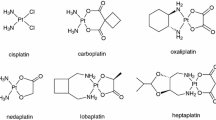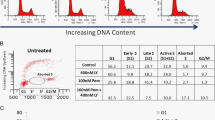Abstract
Three homologous series, each differing from the other in the coordinated amine ligand class, namely alicyclic, heterocyclic or isoaliphatic, were highly effective against wild-type murine leukemia L1210/0 cells in vivo (T/C=171%–426% at optimal doses). Of the 13 complexes comprising the three series, 3 were inactive in the cisplatin-resistant L1210/DDP model, but the other 10 maintained good efficacy (T/C=131%–167%). Longterm survivors, frequently observed with these complexes in the L1210/0 model, were also seen in the L1210/DDP model but to a lesser extent. In the homologous alicyclic series, which contained six analogs, as the alicyclic ring size increased, potency against L1210/0 and L1210/DDP cells also increased up to cyclohexylamine, and then declined. Four ammine/alicyclic amine analogs were evaluated against L1210/DACH cells, which are cross-resistant to tetraplatin, and the clinically predictive M5076 reticulosarcoma. Although the congeners were ineffective or minimally effective in prolonging the survival time of L1210/DACH-bearing mice (T/C=111%–134%), 20%–40% cure rate was consistently observed and suggested that the compounds possessed a low inherent ability to circumvent resistance in these tumor cells also. In the solid M5076 model, activity was greatest (tumor growth delays of about 25 days) for the alicyclic homologs containing the ammine/cyclobutylamine or ammine/cyclopentylamine carrier ligand combination. In summary, ammine/amine platinum (II) analogs have demonstrated promise at the preclinical level in their ability to circumvent acquired resistance, which is a major drawback of cisplatin use in treating cancer.
Similar content being viewed by others
Abbreviations
- DACH:
-
1,2-diaminocyclohexane
- DDP:
-
cisplatin
- T/C:
-
mean lifespan of treated animals compared to controls
- TR:
-
therapeutic ratio
- MTD:
-
maximum tolerated dose
References
Al-Baker S, Siddik ZH, Khokhar AR (1994) Synthesis and characterization of new antitumortrans-R,R-, trans-S,S-andcis-1, 2-diaminocyclohexane platinum(IV) complexes. J Coord Chem 31: 109–116
Begg AC (1987) Principles and practices of the tumor growth delay assay. In: Kallman RF (ed) Rodent tumor models in experimental cancer therapy. Pergamon Press, New York, pp 114–121
Blatter EE, Vollano JF, Krishnan BS, Dabrowiak JC (1984) Interaction of the antitumor agentscis, cis trans-PtIV (NH3)2Cl2(OH)2 andcis, cis, trans-PtIV [(CH3)2CHNH2]2Cl2(OH)2 their reduction products with PM2 DNA. Biochemistry 23: 4817–4820
Borch RF (1987) The platinum anti-tumour drugs. In: Powis G, Prough RA (eds) Metabolism and action of anti-cancer drugs. Taylor & Francis, London, pp 163–193
Borch RF, Markman M (1989) Biochemical modulation of cisplatin toxicity. Pharmacol Ther 41: 371–380
Braddock PD, Connors TA, Jones M, Khokhar AR, Melzack DH, Tobe ML (1975) Structure and activity relationships of platinum complexes plexes with anti-tumor activity. Chem-Biol Interact 11: 145–161
Burchenal JH, Kalaher K, O'Toole T, Chisholm J (1977) Lack of cross-resistance between certain platinum coordination compounds in mouse leukemia. Cancer Res 37: 3455–3457
Chaney, SG, Wyrick S, Till GK (1990) In vitro biotransformation of tetrachloro(d, l-trans) 1, 2-diaminocyclohexaneplatinum(IV) (tetraplatin) in rat plasma. Cancer Res 50: 4539–4545
Christian MC (1992) The current status of new platinum analogs. Semin Oncol 19: 720–733
Cleare MJ (1983) Structure-activity relationships for anti-tumour platinum complexes. In: Reinhoudt DN, Connors TA, Pinedo HM, van de Poll KW (eds) Structure-activity relationships of anti-tumour agents. Martinus Nijhoff, The Hague, pp 59–91
Eastman A (1987) Glutathione-mediated activation of anticancer platinum(IV) complexes. Biochem Pharmacol 36: 4177–4178
Eastman A, Illenye S (1984) Murine leukemia L1210 cell lines with different patterns of resistance to platinum coodination complexes. Cancer Treat Rep 68: 1189–1190
Eastman A, Schulte N, Sheibani N, Sorenson CM (1988) Mechanisms of resistance to platinum drugs. In: Nicolini M (ed) Platinum and other metal coordination compounds in cancer chemotherapy. Martinus Nijhoff, Boston, pp 178–196
Farrell N, Qu Y, Hacker MP (1990) Cytotoxicity and antitumor activity of bis(platinum) complexes: a novel class of platinum complexes active in cell lines resistant to cisplatin and 1, 2-diaminocyclohexane complexes. J Med Chem 33: 2179–2184
Geran RI, Greenberg NH, Macdonald MM, Schumacher AM, Abbott BJ (1972) Protocols for screening chemical agents and natural products against animal tumors and other biological systems (third edition). Cancer Chemother Rep 3: 1–103
Giandomenico CM, Abrams MJ, Murrer BA, Vollano JF, Barnard CFJ, Harrap KR, Goddard PM, Kelland LR, Morgan SE (1991) Synthesis and reactions of a new class of orally active Pt(IV) antitumor complexes. In: Howell SB (ed) Platinum and other metal coordination compounds in cancer chemotherapy. Plenum Press, New York, pp 93–100
Gibbons GR, Wyrick S, Chaney SG (1989) Rapid reduction of tetrachloro (D, L-trans) 1, 2-diaminocyclohexaneplatinum (IV) (tetraplatin) in RPMI 1640 tissue culture medium. Cancer Res 49: 1402–1407
Harrap KR (1983) Platinum analogues: criteria for selection. In: Muggia FM (ed) Cancer chemotherapy, vol 1. Martinus Nijhoff, Boston, pp 171–217
Harrap KR, Kelland LR, Jones M, Goddard PM, Orr RM, Morgan SE, Murrer BA, Abrams MJ, Giandomenico CM, Cobbleigh T (1991a) Platinum coordination complexes which circumvent cisplatin resistance. Adv Enzyme Regul 31: 31–43
Harrap KR, Murrer BA, Giandomenico C, Morgan SE, Kelland LR, Jones M, Goddard PM, Schurig J (1991b). Ammine/amine platinum IV dicarboxylates: a novel class of complexes which circumvent intrinsic cisplatin resistance. In: Howell SB (ed) Platinum and other metal coordination compounds in cancer chemotherapy. Plenum Press, New York, pp 391–399
Kelland LR, Murrer BA, Abel G, Giandomenico CM, Mistry P, Harrap KR (1992) Ammine/amine platinum(IV) dicarboxylates: a novel class of platinum complex exhibiting selective cytotoxicity to intrinsically cisplatin-resistant human ovarian carcinoma cell lines. Cancer Res 52: 822–828
Kelland LR, Abel G, McKeage MJ, Jones M, Goddard PM, Valenti M, Murrer BA, Harrap KR (1993) Preclinical antitumor evaluation of bis-acetato-ammine-dichloro-cyclohexylamine platinum(IV): an orally active platinum drug. Cancer Res 53: 2581–2586
Khokhar AR, Al-Baker S, Siddik ZH (1993a) Synthesis and antitumor activity of 1, 2-diaminocyclohexane platinum (IV) complexes. J. Inorg Biochem 54: 39–47
Khokhar AR, Deng Y, Al-Baker S, Yoshida M, Siddik ZH (1993b) Synthesis and antitumor activity of ammine/amine platinum(II) and (IV) complexes. J Inorg Biochem 51: 677–687
Kido Y, Khokhar AR, Al-Baker, S, Siddik ZH (1993) Modulation of cytotoxicity and cellular pharmacology of 1, 2-diaminocyclohexane platinum(IV) complexes mediated by axial and equatorial ligands. Cancer Res 53: 4567–4572
Loh SY, Mistry P, Kelland LR, Abel G, Harrap KR (1992) Reduced drug accumulation as a major mechanism of acquired resistance to cisplatin in a human ovarian cell line: circumvention studies using novel platinum (II) and (IV) ammine/amine complexes. Br J Cancer 66: 1109–1115
Norusis MJ (1993) SPSS for windows: advanced statistics, release 6.0. SPSS, Chicago, pp 259–274
Ozols RF, Hamilton TC, Reed E, Poirier MC, Masuda, H, Lai G, Young RC (1988) High dose cisplatin and drug resistance: clinical and laboratory correlations. In: Nicolini M (ed) Platinum and other metal coordination compounds in cancer chemotherapy. Martinus Nijhoff, Boston, pp 197–206
Pendyala L, Arakali AV, Sansone P, Cowens JW, Creaven PJ (1990) DNA binding of iproplatin and its divalent metabolitecis-dichloro-bis-isopropylamine platinum(II). Cancer Chemother Pharmacol 27: 248–250
Prestayko AW, Bradner WT, Huftalen JB, Rose WC, Schurig JE, Cleare MJ, Hydes PC, Crooke ST (1979a) Antileukemic (L1210) activity and toxicity ofcis-dichlorodiammineplatinum(II) analogs. Cancer Treat Rep 63: 1503–1508
Prestayko AW, D'Aoust JC, Issell BF, Crooke ST (1979b) Cisplatin (cis-diamminedichloroplatinum II). Cancer Treat Rev 6: 17–39
Richon VM, Schultz N, Eastman A (1987) Multiple mechanisms of resistance tocis-diamminedichloroplatinum(II) in murine, leukemia L1210 cells. Cancer Res 47: 2056–2061
Rose WC (1986) Evaluation of Platinol analogs using the M5076 murine sarcoma. Anticancer Res 6: 557–562
Rose WC, Schurig JE, Huftalen JB, Bradner WT (1982) Antitumor activity and toxicity of cisplatin analogs. Cancer Treat Rep 66: 135–146
Salem P, Khalyl M, Jabboury K, Hashimi L (1984)cis-Diamminedichloroplatinum (II) by 5-day continous infusion. Cancer 53: 837–848
Schilder RJ, Ozols RF (1992) New therapies for ovarian cancer. Cancer Invest 10: 307–315
Siddik ZH, Al-Baker S, Burditt TL, Khokhar AR (1993) Differential antitumor activity and toxicity of isomeric 1, 2-diaminocyclohexane platinum (II) complexes. J Cancer Res Clin Oncol 120: 12–16
Siddik ZH, Al-Baker S, Burditt TL, Khokhar AR (1994) Modulatory effect of axial and equatorial ligands on antitumor activities oftrans-1R, 2R-diaminocyclohexane platinum(IV) complexes. Anti-Cancer Drug Design 9: 139–151
Teicher BA, Herman TS, Holden SA, Wang YY, Pfeffer MR, Crawford JW, Frei E (1990) Tumor resistance to alkylating agents conferred by mechanisms operative only in vivo. Science 247: 1457–1461
Timmer-Bosscha H, Mulder NH, Vries EGE de (1992) Modulation ofcis-diamminedichloroplatinum(II) resistance: a review. Br J Cancer 66: 415–425
Yoshida M, Khokhar AR, Kido Y, Al-Baker S, Siddik ZH (1993) Structure-cytotoxicity relationship for alicyclic mixed amine platinum(II) complexes. Proc Am Assoc Cancer Res 34: 405
Author information
Authors and Affiliations
Additional information
This work was supported by NIH grants RO1 CA50380 and RO1 CA41581, and in part by NIH Cancer Center (Core) support grant PO30 CA16672
Rights and permissions
About this article
Cite this article
Siddik, Z.H., Thai, G., Yoshida, M. et al. Ammine/amine platinum (II) complexes effective in vivo against murine tumors sensitive or resistant to cisplatin and tetraplatin. J Cancer Res Clin Oncol 120, 571–577 (1994). https://doi.org/10.1007/BF01212810
Received:
Accepted:
Issue Date:
DOI: https://doi.org/10.1007/BF01212810




